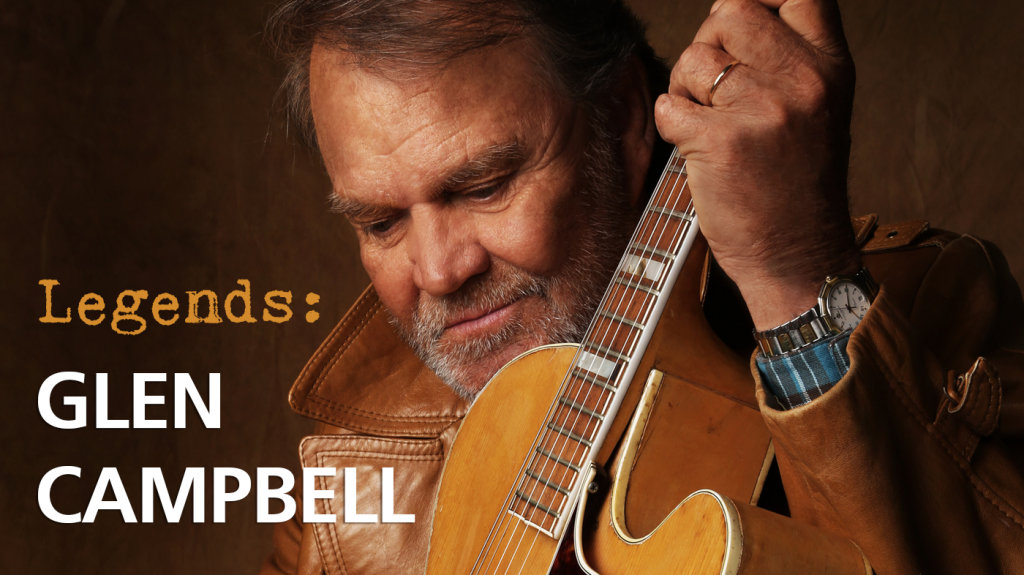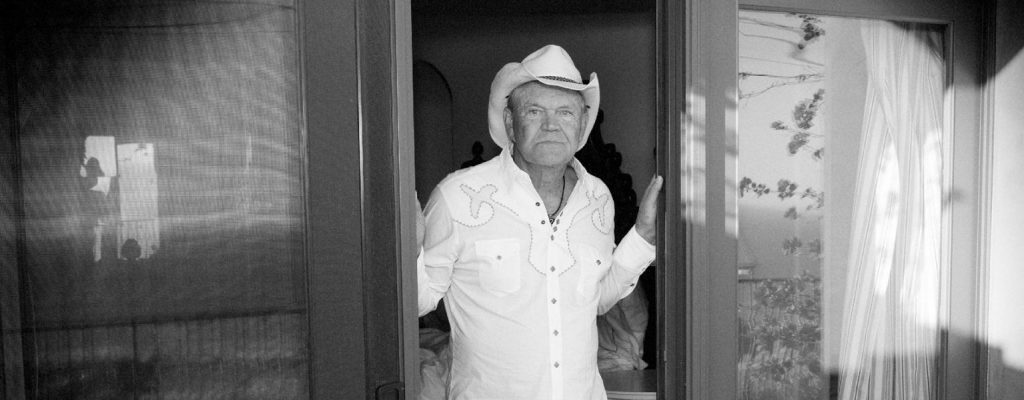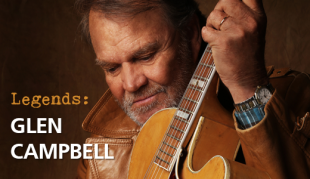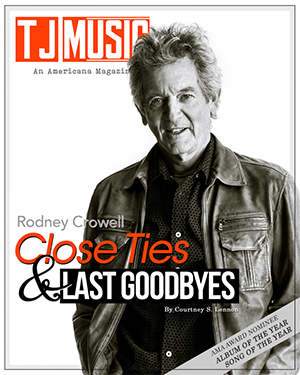By Terry Paul Roland
If life is merely a passage, as I believe it is, then once the journey through this valley of tears has ended, “A better place awaits, you’ll see,” as Glen Campbell sang on his 2011 release, Ghost on the Canvas.
The album was followed by a subsequent farewell tour and the award-winning film, I’ll Be Me, which launched Campbell’s brave, public battle with Alzheimer’s disease, bringing national attention to it. The film, an example of the redeeming, healing power of music. Campbell’s struggle brought his family, friends and fans together in an unparalleled display of love. The great session guitarist of the Wrecking Crew and solo artist, who was one of the main figures of the last 50 years to bring country music to the mainstream, died on August 8, 2017 after a near-decade long battle with Alzheimer’s.
While the news comes without surprise, there is still a sense of loss for all of those who loved, admired and fought with him. As Larry Gatlin said in an interview in I’ll Be Me, “I saw Glen Campbell at Ryman Auditorium. I laughed, I cried and I learned.”
Campbell was a true artist. He was a songwriter, instrumentalist, entertainer, singer and performer. He was a man who succeeded on many levels. Some of his accomplishments are not as well known as others. In his last years, he showed the same public who were raised with his music how to grow old and die with love, humility, respect and gratitude. But beneath it all, he always remained the country boy from Arkansas with a sharp sense of humor. By a near-miracle, the music that was born into him became the last to leave. In the end, during the years when Alzheimer’s haunted him most, he finished three albums, one soundtrack and 150 concert dates. His connection with the muse was so great, it never seemed to let him go until the very end.
Campbell first began to appear on recordings heard on AM radios throughout America in 1961. Without knowing it, his brilliant and soulful guitar playing was routinely heard on so many hit songs from 1961 to 1964. With a legacy of songs, a national hit television show, movies (he once starred alongside John Wayne in True Grit) and constant live performances, he became part of the American fabric for the millions who loved him.
From his Arkansas roots, to his time playing in his Uncle’s band in New Mexico in 1954, Campbell made his way to Los Angeles. The year was 1960. He arrived at a time of transition in music and culture. By that year, Capital Records was the top label for popular music. Based on the model Frank Sinatra championed, rock & roll depended on songwriters and arrangers to create hit songs. It was the era of the teen-idols, the folk music revival, and surf-music.
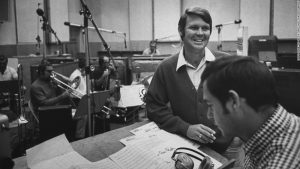 But, skilled musicians were needed in the studio. A new breed of diverse instrumentalists, who would later become known as The Wrecking Crew, grew from the demand. Much like the songwriters of the Brill Building in New York City, these musicians were called on for their expertise and their efficiency in creating the music for the hit songs of the day. Glen Campbell landed with them in 1961 performing on hit records with the most popular artists of the day including Bobby Darin, Ricky Nelson, Dean Martin, Nat King Cole, The Monkees, Nancy Sinatra, Merle Haggard, Jan and Dean, Elvis Presley, Frank Sinatra.
But, skilled musicians were needed in the studio. A new breed of diverse instrumentalists, who would later become known as The Wrecking Crew, grew from the demand. Much like the songwriters of the Brill Building in New York City, these musicians were called on for their expertise and their efficiency in creating the music for the hit songs of the day. Glen Campbell landed with them in 1961 performing on hit records with the most popular artists of the day including Bobby Darin, Ricky Nelson, Dean Martin, Nat King Cole, The Monkees, Nancy Sinatra, Merle Haggard, Jan and Dean, Elvis Presley, Frank Sinatra.
As part of the Wrecking Crew, alongside drummer Hal Blaine and bassist Carol Kaye, Campbell was instrumental in the development of Phil Spector’s legendary ‘Wall of Sound’ and his proficient playing helped Brian Wilson create the Beach Boys albums Wilson imagined in his head, including the pivotal 1966 album, Pet Sounds. Campbell was there on the front lines as rock music grew into something entirely new. A different sound from the rock ‘n’ roll of the 50s.
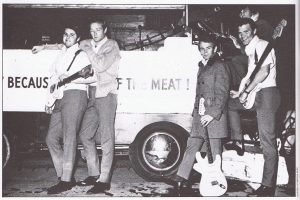 Campbell became a member of the Beach Boys in 1964 after Brian Wilson had a breakdown and stopped touring. It was then that Campbell went from being a session musician to effortlessly taking on the soaring vocals the Beach Boys lost on the road when Brian opted to stay home. Campbell’s talent exceeded beyond being in the background. Though he had recorded singles before, along with other artists or under a pseudonym, he stepped into his own at that time. His breakout as an artist was the 1965, Brian Wilson penned single, “I Guess I’m Dumb,” which he sang with a falsetto croon. It was here where Campbell was given the opportunity to be at the forefront. His way of interpreting songs, truly special. Even with blaring orchestral sounds in the background, his voice cut through as he sang with desperation, pain and at the same time, hopefulness. Campbell proved he was a true artist, not just a session musician. And that he had the perfect voice to sing country records.
Campbell became a member of the Beach Boys in 1964 after Brian Wilson had a breakdown and stopped touring. It was then that Campbell went from being a session musician to effortlessly taking on the soaring vocals the Beach Boys lost on the road when Brian opted to stay home. Campbell’s talent exceeded beyond being in the background. Though he had recorded singles before, along with other artists or under a pseudonym, he stepped into his own at that time. His breakout as an artist was the 1965, Brian Wilson penned single, “I Guess I’m Dumb,” which he sang with a falsetto croon. It was here where Campbell was given the opportunity to be at the forefront. His way of interpreting songs, truly special. Even with blaring orchestral sounds in the background, his voice cut through as he sang with desperation, pain and at the same time, hopefulness. Campbell proved he was a true artist, not just a session musician. And that he had the perfect voice to sing country records.
Though the single wasn’t a hit, from there, Capital Records saw Campbell’s charm, charisma, talent and signed him to the label. After a series of failed singles and minor country hits, in 1967, he recorded an obscure song by an unknown singer-songwriter and banjo player, John Hartford. “Gentle on My Mind became a monster cross-over hit landing at #1 on both country and pop charts.
With the success of “Gentle on my Mind,” his follow-up song was even more successful. Jimmy Webb’s “By the Time I Get to Phoenix,” led to a legendary collaboration with the L.A. songwriter. Their follow-up hits, “Galveston” and “Wichita Lineman” are now considered part of the Great American Songbook.
 His successful television variety show, The Glen Campbell Goodtime Hour, further cemented his status in American music and established him as a live performer, whose guitar antics bordered on the miraculous. Campbell’s legacy and musical contribution are as lasting and timeless as any of the legends music who pioneered their way through the last half of the 20th century including Frank Sinatra, Ray Charles, Johnny Cash and Willie Nelson.
His successful television variety show, The Glen Campbell Goodtime Hour, further cemented his status in American music and established him as a live performer, whose guitar antics bordered on the miraculous. Campbell’s legacy and musical contribution are as lasting and timeless as any of the legends music who pioneered their way through the last half of the 20th century including Frank Sinatra, Ray Charles, Johnny Cash and Willie Nelson.
The measure of man, may not always be seen in how he lived but also how he faces his own mortality. If so, then, in 2011, when Glen Campbell went public with the diagnosis of Alzheimer’s Disease, he became a giant in the public eye. It was a decision that would not only create a swell of love and support from fans, but would cause him to create the finest music of his career.
After two years of work on a seminal recording that addressed aging and mortality, Glen Campbell and family embarked on the goodbye tour. His quiet masterpiece, Ghost on the Canvas, written and produced with Julian Raymond, was a revelation. It is rare when an artist allows his public close enough to his personal vulnerability and frailty to witness the miracle and redeeming power of song. Campbell and family, and especially his wife Kim, did just this. The film chronicles the decision that was a healthy one for the public and for Glen.
Ghost on the Canvas is an expertly produced pop opera and meditation, akin to Brian Wilson’s Pet Sounds. If Wilson’s opus was a homage to the ache and struggle of coming of age at life’s beginning, then Glen Campbell’s work is a contemplation on an artist coming to terms with aging and the final things that we all must face. The album is an act of willful grace, gratitude and love. Ironically, one of the ingredients that makes the album so successful is the presence of songs by younger alternative rockers like Paul Westerberg, who wrote the title song.
As Campbell toured with the support of his children-who became the core of his band, he showed the kind of courage that is hardly seen in American music. In the fall of 2011, I was at the Club Nokia show in Los Angeles. What I experienced was a skilled, joyful, happy and passionate performer surrounded by family and fans. There was no sad or maudlin sentiments that night. There was an absence of pity as Campbell took the stage with confidence and grace. The audience were there to cheer him on. There was a tangible feeling of love in the air.
His guitar work was adventurous and imaginative. It was a night to witness the miracle of music. It’s unifying and redeeming power. It was truly Glen’s night. It was a celebration. There were awkward moments when the evidence of Alzheimer’s crept in. But, the moments were minor and were quickly covered by his band. Then, on the rebound, he would shoot out licks from his guitar that recovered it all.
When the tour was complete, Campbell entered the studio in Nashville for one last time. His final album, Adios, was recorded between 2012 and 2013 with producer and life-long friend, Carl Jackson. It is a return to the style of recording Campbell championed on his first hit albums. With an easy country feel, he was joined by Willie Nelson on “Funny How Time Slips Away,” Vince Gill on Roger Miller’s “Am I All Alone (Or Is It Only Me),” along with his children Ashley, Shannon and Cal.
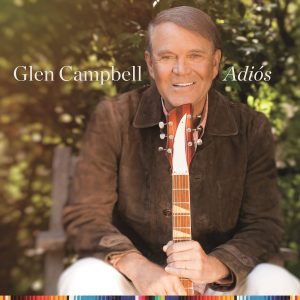 Singing his final song on this farewell album released just two months before his passing, it’s a marvel to hear the tear in his voice as he sings “adios,” in that natural country stream that runs through his pitch-perfect voice. As with Ghost on the Canvas, there is a sense of urgency and authenticity. The song and his final albums are about paying tribute to a life well-lived and well-loved.
Singing his final song on this farewell album released just two months before his passing, it’s a marvel to hear the tear in his voice as he sings “adios,” in that natural country stream that runs through his pitch-perfect voice. As with Ghost on the Canvas, there is a sense of urgency and authenticity. The song and his final albums are about paying tribute to a life well-lived and well-loved.
There’s no doubt that Glen Campbell’s place in American music is secured. He’ll be known for how accessible he made his music with a sense of real love. He could play guitar like no one else of his time despite having no formal training.
As his voice and songs reach back to our common love of life; his last days have shown how to face life with acceptance and a kind of love that only comes from a soul who could hear the song we all yearned for and, even as he died, bring that music to life.
Donations can be made to the Glen Campbell Memorial Fund at BrightFocus Foundation through the CareLiving.org donation page.
Terry Roland
Latest posts by Terry Roland (see all)
- John Prine: An Appreciation - April 21, 2020
- Kinky Friedman: Deep in the Heart of Texas - June 18, 2018
- Chris Hillman’s Still Flying High on New Album, Bidin’ My Time - December 8, 2017

